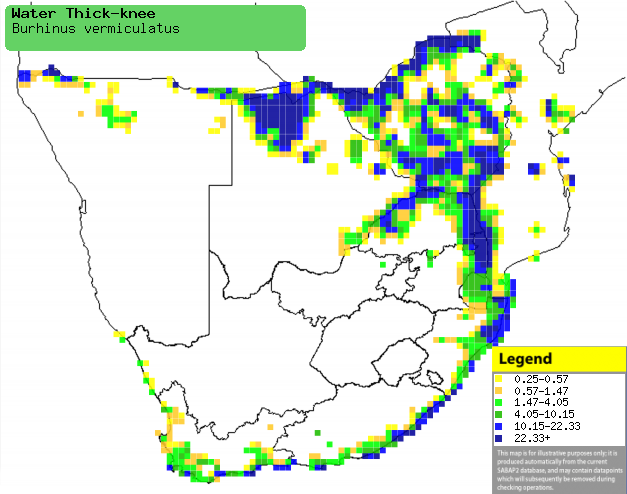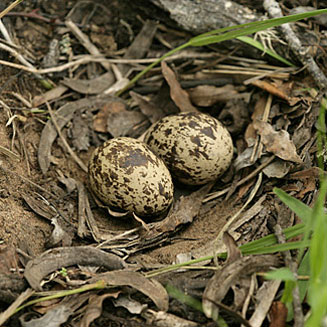|
Burhinus vermiculatus (Water
thick-knee, Water dikkop)
Waterdikkop [Afrikaans]; Ingqangqolo (generic term
for thick-knee) [Xhosa]; Eswaita (term used for both species of dikkop) [Kwangali];
Umunkonkoni (generic term for thick-knee) [Swazi]; Mtshikuyana (generic term for
dikkop) [Tsonga]; Watergriel [Dutch]; Oedicnème vermiculé [French];
Wassertriel [German]; Alcaravão-d'água [Portuguese]
Life
> Eukaryotes >
Opisthokonta
> Metazoa (animals) >
Bilateria >
Deuterostomia > Chordata >
Craniata > Vertebrata (vertebrates) > Gnathostomata (jawed
vertebrates) > Teleostomi (teleost fish) > Osteichthyes (bony fish) > Class:
Sarcopterygii (lobe-finned
fish) > Stegocephalia (terrestrial
vertebrates) > Tetrapoda
(four-legged vertebrates) > Reptiliomorpha > Amniota >
Reptilia (reptiles) >
Romeriida > Diapsida > Archosauromorpha > Archosauria >
Dinosauria
(dinosaurs) > Saurischia > Theropoda (bipedal predatory dinosaurs) >
Coelurosauria > Maniraptora > Aves
(birds) > Order: Charadriiformes
Distribution and habitat
Occurs in the lowlands of sub-Saharan Africa, from Liberia
to Ethiopia discontinuously south to southern Africa. Within southern Africa it is locally common
in Zimbabwe, patches of Mozambique, eastern and southern South Africa, northern
and eastern Botswana and northern Namibia (including the Caprivi Strip). It
generally prefers freshwater wetlands, especially dams, lakes and large rivers
but also mangroves, estuaries and open banks.
|
 |
|
Distribution of Water thick-knee in southern Africa,
based on statistical smoothing of the records from first SA Bird Atlas
Project (©
Animal Demography unit, University of
Cape Town; smoothing by Birgit Erni and Francesca Little). Colours range
from dark blue (most common) through to yellow (least common).
See here for the latest distribution
from the SABAP2. |
Movements and migrations
It is nomadic, moving in response to changing
water levels.
Food
It mainly eats insects, other invertebrates, frogs and
tadpoles, doing most of its foraging in a plover-like manner, repeatedly running
forward a bit before pausing and jabbing at prey. The following food items have been recorded
in its diet:
- Animals
- Invertebrates
- insects
- crustaceans
- crabs
- Potamon perlatus (Cape river crab)
- giant
millipedes
- worms
- Vertebrates
- frogs and tadpoles
- Aethomys namaquensis (Namaqua rock mouse)
- other
- Solen cylindraceus (Pencil bait discarded by anglers)
- grass seeds
Breeding
- Monogamous, solitary nester, using a simple scrape in the ground, which is either
unlined or lined with vegetation, stone chips and dry mud. It is typically
placed in a fairly open position close to water, often adjacent to a sand
dune, piece of driftwood or animal dung.
 |
|
|
Water dikkop nest with eggs, Bonamanzi, South
Africa. [photo Warwick Tarboton ©] |
|
- Egg-laying season is from August-January, peaking from September-December.
- It lays 1-3 eggs, which are incubated by both sexes for about 22-25
days.
- The development and care of the chicks has not been properly studied,
other then that the chicks fledge at approximately 60-63 days old.
Threats
Not threatened, in fact it has probably benefited from the
introduction of man-made water bodies.
References
-
Hockey PAR, Dean WRJ and Ryan PG 2005. Roberts
- Birds of southern Africa, VIIth ed. The Trustees of the John Voelcker
Bird Book Fund, Cape Town.
|
